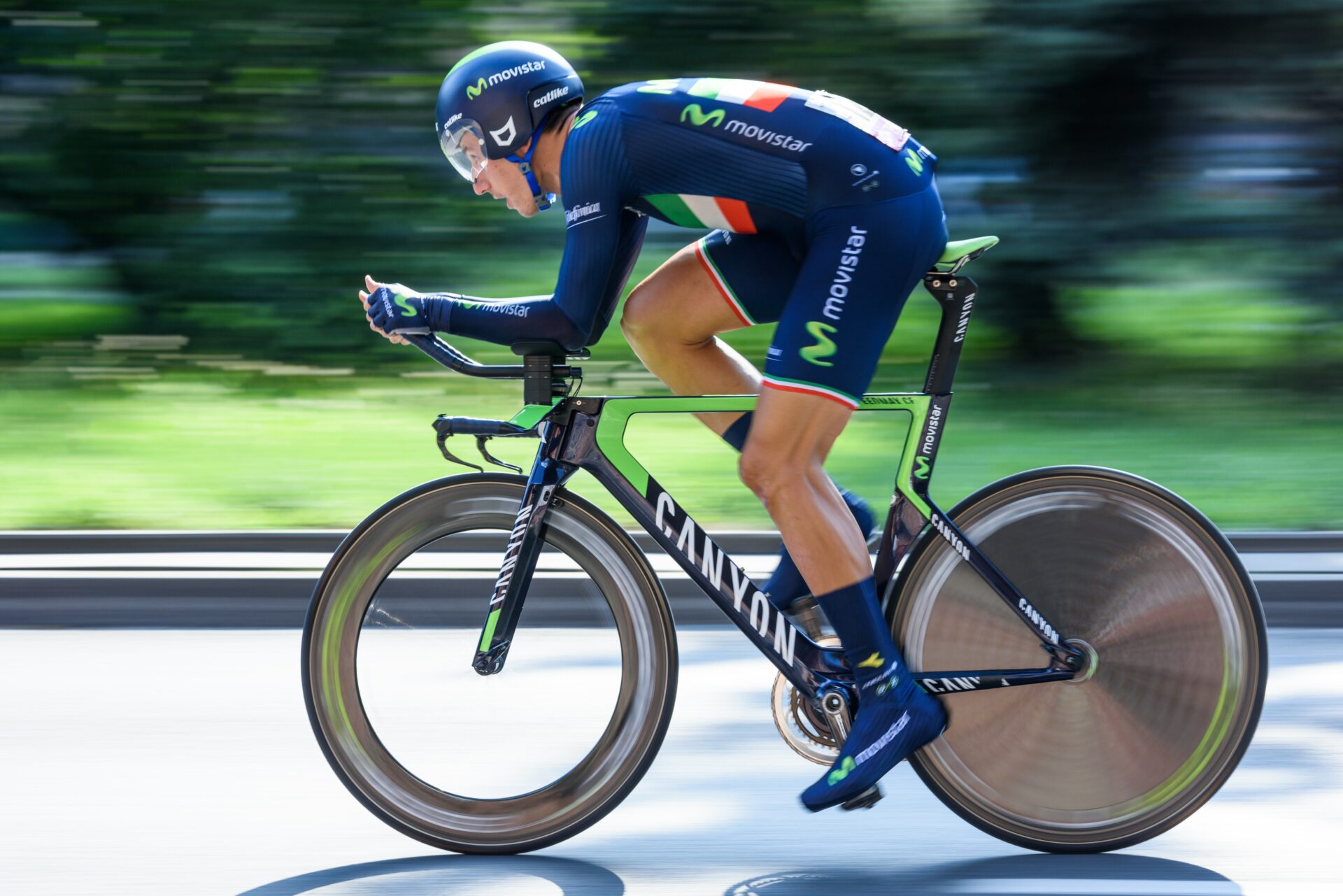If you want to improve your FTP, having a well-structured training plan is as essential as doing specific individual workouts designed to target your functional threshold power.
So, in this article, I show you how to write out training months and weeks and what individual threshold workouts should look like, to let that FTP score improve.
You might already think about the workouts, but there’s not just one way to raise your FTP.
There Are Many Ways to Improve Your FTP
Functional threshold power is a measurement we use to assess a cyclist’s current fitness level. For that reason, there’s not just one way to increase your FTP from 200 to 300 watts or increase it by 50 watts or even 100 watts, for example. It depends on different factors like your ability as a cyclist and requires purposeful planning.
Because if you’re a beginner you could virtually do anything –apart from binge-watching another Netflix series or checking your Instagram feed thousands of times on repeat– and see that FTP increase.
However, I think you read this article because you passed that point and you’re looking for specific ways to see your FTP increase.
The truth is that all workouts you do, from the zone 2 endurance ride to high-intensity intervals, bring up your FTP. The difference lies in the rate it increases your FTP and how sustainable that rate is.
In a systematic review of high-volume vs. high-intensity training, it’s stated that both low-intensity and high-intensity training play an important role in a structured training program. And that training adaptation that was found with low-intensity training was not observed in high-intensity activity above FTP.
On the one hand, Zone 2 training will improve your FTP more slowly over time, while not causing diminishing returns as fast as high-intensity training. On the other hand, high-intensity training enhances your FTP very quickly, but you reach the point of failing adaptation fairly quickly. This is why you want to incorporate your high-intensity intervals at least a month before your goal event.
As we got this point out of the way, let’s look at how to structure your training months and weeks.
Follow me on Instagram for more Cycling Content.
How to Build a Training Plan to Raise FTP
A poorly created training plan can see your FTP not improving although you have perfectly designed FTP-focused workouts. Do them at the wrong frequency or at the wrong time and you may ditch your potential.
Here’s how to build your training months and weeks.
The Training Month
For your training month, you want three weeks of increasing training load. This is called progressive overload. You can do this by increasing training volume or intensity or both.
For example, for a criterium race, you may want to increase intensity. On the other hand, for an ultra-endurance event, you may want to increase volume. You want to do this because our bodies adapt to the stress we give them. Change your training over time and you prevent regress. Besides, this will make your workouts more specific to the demand of the event.
The fourth week should be a rest week. You build up fatigue during those intense three weeks. And you need to remove that fatigue to recover and soak up the training. Otherwise, you may get burned out and return to Netflix binge-watching.
The training months should be clear now, let’s get a bit more specific by looking at the training week.
The Training Week
During the training week, the biggest thing most cyclists get wrong is the frequency of their high-intensity or FTP interval workouts. 2 or on occasion 3 interval sessions per week are optimal to maximize performance. Do more and you may end up with overtraining symptoms.
You wanna do these important sessions when you’re the freshest, which is after rest days. For example, if you take Monday and Friday off, Tuesday and Saturday will be your interval days.
Once you have your interval days, the rest of the rides should be endurance rides referred to as Zone 2 training in a 6-Zone model. This is a somehow comfortable pace you can hold for a very long time. Check out my article about Zone 2 training to better execute yours.
And I encourage you to do at least one long ride per week.
Because there are specific adaptations you gain from a long ride that you don’t get from any other session. Long rides cause a chain reaction of effects.
Firstly, your body’s glycogen becomes depleted, causing your slow-twitch muscle fibers and some fast-twitch fibers to fatigue. Secondly, fatigue leads to the recruitment of more fast twitch fibers forced to do endurance work. Lastly, fast-twitch fibers become more enduring, and your body’s ability to use fat as a fuel source improves. And all this happens through easily repeated muscle contraction.
As we’re done with planning let’s talk about specific FTP workouts.
Raise Your FTP With My Essential Training Plans
- RV Increase Your FTP in 8 Weeks on 6 Hours, 10 Hours or 15 Hours
- RV Road Racing Advanced Build Plan 10 Hours (8 Weeks)
- RV Gravel Advanced Build Plan for UCI Racing 10 Hours (8 Weeks)
- RV Gran Fondo Advanced Build Plan 10 Hours (8 Weeks)
Specific FTP Focused Workouts
As I’ve said already, all sessions influence your FTP but we focus on the specific workouts that aim to do so.
There are 3 types of workouts that we want to focus on: Tempo intervals done at 85-90% of your FTP, and threshold intervals done at 95-100% of your FTP. In addition, over-under intervals seem to deliver great results in improving your threshold power. There’s not a lot of research done on these yet but the idea makes a lot of sense. I wrote a whole article about lactate clearance here. As a plus, I added an example of a Vo2max interval session that you can use for peaking before your goal event.
How much total interval time you do during a session depends on your ability as a cyclist.
A beginner could do 45 minutes total at Tempo and a pro 90 minutes or more. For threshold intervals, a beginner could do 30 minutes of work and pro as much as an hour. And for over-under intervals, a beginner could start with 2x12min and a pro smash a 2x20min workout.
The sweet spot for interval length at tempo is 20-45 minutes and 10-20 minutes for threshold intervals. For rest periods choose one-fourth to one-half of the interval time. For example, for a 10-minute interval, you may do 2.5 minutes or 5 minutes of rest in between.
Enough writing, let’s put theory into practice with a couple of example workouts covering the three types that will improve your FTP.
Tempo Intervals:
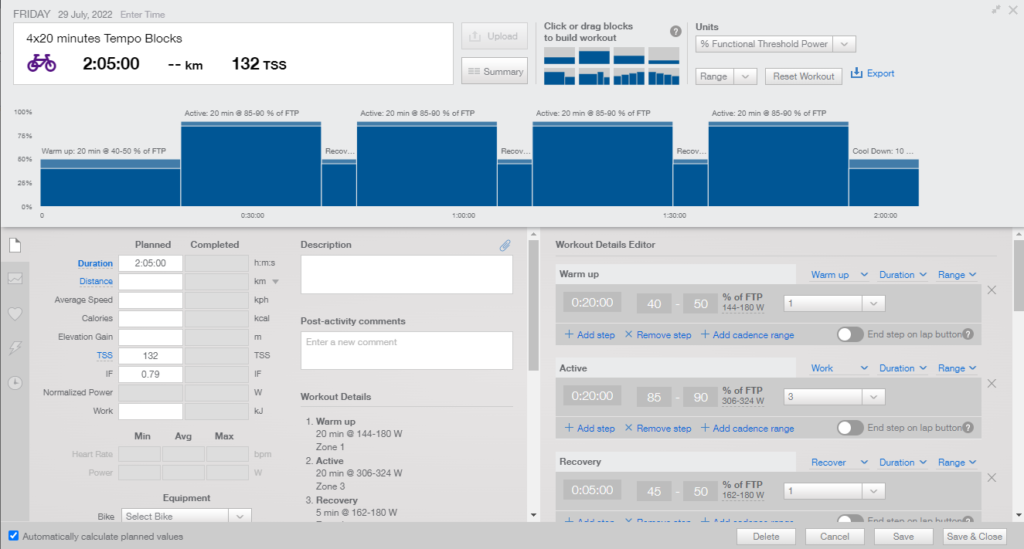
FTP intervals
Beginner:
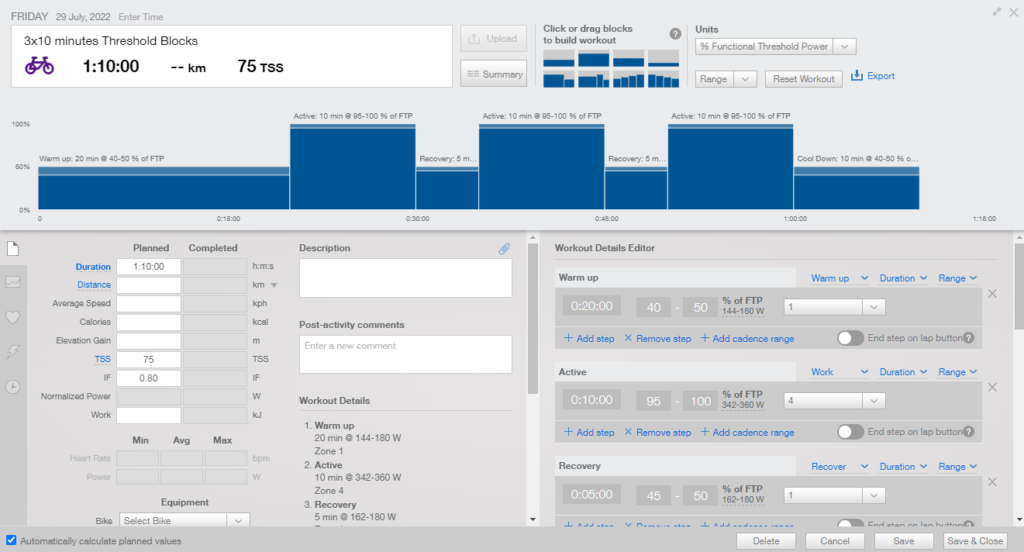
Intermediate:
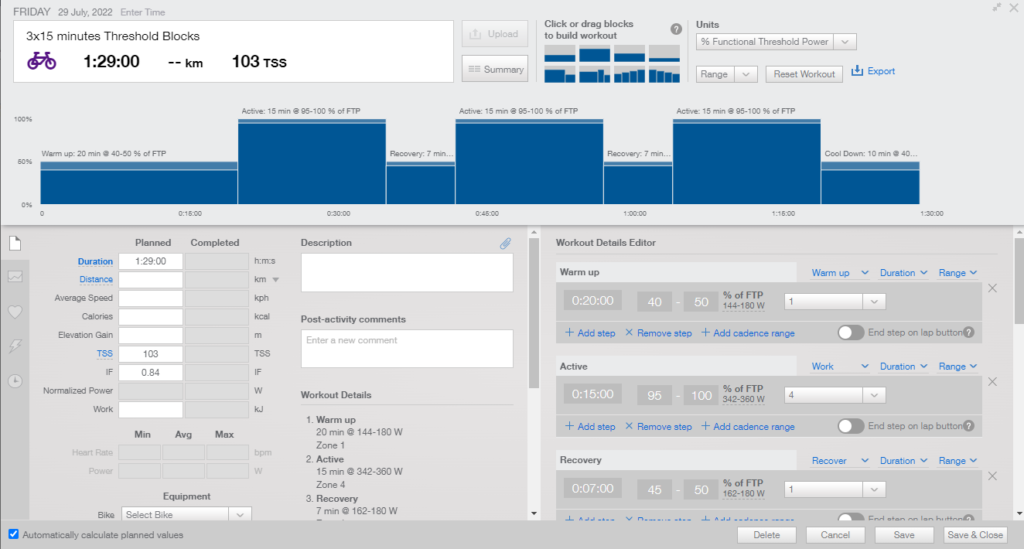
Pro:
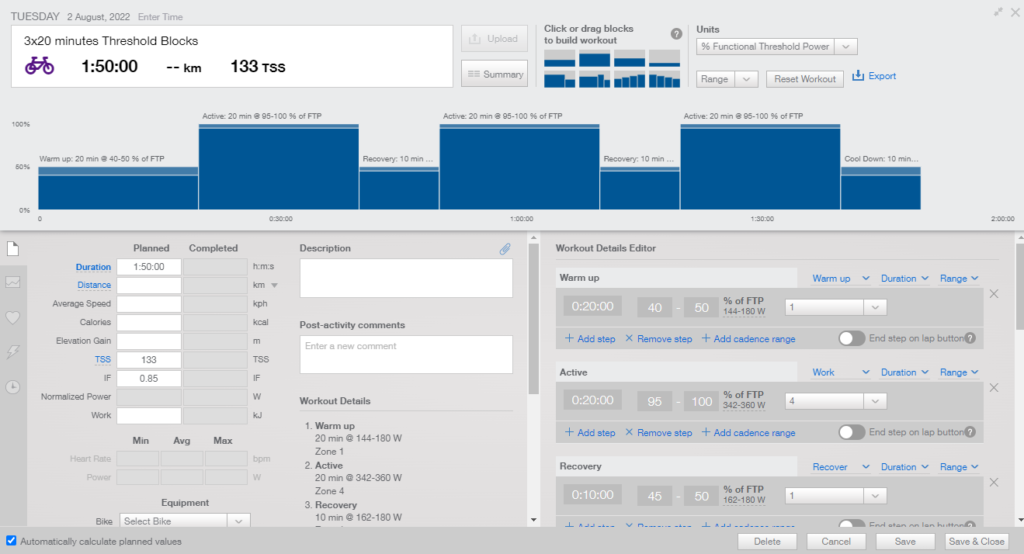
Over-Under Intervals:

VO2max Intervals for Peaking:

Putting it all together
As you can see, FTP workouts don’t need to be complex to improve your FTP.
You may have seen very complicated workouts. Sessions you need to print on your stem to remember. But these workouts are not backed by a lot of science. They are just made to catch your attention.
You don’t need to shoot every zone in one session. You just need to accumulate time in target zones to signal adaptation.
But for sure, you improve other areas of your fitness with target intervals because multiple systems work simultaneously in your body. For example, VO2max intervals improve mainly VO2max but also increase your FTP. However, the contribution of each system differs.
So, stick to two or occasionally three interval sessions per week, do the rest of the rides at Zone 2 endurance pace, and work on progressive overload. Fit a rest week every 3 or 4 weeks to recharge. With that in mind, you are primed to improve your FTP.
Ready to Improve Your FTP?
If you enjoyed this and want to improve your FTP, then get your hands on one of my plans, available on TrainingPeaks, and ride faster for longer, or click below to get my specific base, build, and peak plans for amateur and elite cyclists:
- RV The Block Periodization Plan, 4 Weeks (6 Hours)
- RV Improve Your FTP, 8 Weeks on 6 Hours, 10 Hours, or 15 Hours
- RV Unbound 200 Three Phases Peak Plan Advanced 10 Hours (8 Weeks)
Follow me on Instagram for more Cycling Content.
Check out my Favorite Performance Gear and Nutrition:
- *Polar H9 Heart Rate Monitor (My Price-Performance Winner)
- *SiS Beta Fuel Energy Gel (90-120g/h Carb Ingestion)
- *Wahoo Elemnt Roam V2 Bike Computer
- *Shockz OpenRun Pro earphones for responsible listening
- *Powerbar Isoactive Powder (Up to 90g/h Carb Ingestion)
Discover my Favorite Gear from my Friends at bike-components.de:
- *Favero Assioma Duo Power Meter Pedals
- *Oakley Sutro Lite Glasses
- *Specialized Prevail 3 MIPS Helmet
- *S-Works Torch Shoes
- *Specialized Pathfinder Pro
- *Vittoria Corsa Control Tires
Shop my Favorite Gear From Specialized:
- *S-Works Torch Shoes
- *Specialized Torch 3.0 Shoes
- *Specialized Prevail 3 MIPS Helmet
- *Specialized Pathfinder Pro
Get the Newsletter
Receive pragmatic cycling advice, great stories, and training analyses from pro cyclists delivered to your inbox each week.
Footnotes
- Training Fast Twitch Muscle Fibers: Why and How
- What is best practice for training intensity and duration distribution in endurance athletes?
- Training for intense exercise performance: high-intensity or high-volume training?
- Specific Intensity for Peaking: Is Race Pace the Best Option?
- The Effect of Different High-Intensity Periodization Models on Endurance Adaptations
Ad Hint for Asterisk Links
*Asterisks are affiliate links from services and gear I use and love. If you take action (i.e. make a purchase) I’ll earn some coffee money which I promise to drink while you enjoy the content and offers. You don’t pay a higher price.
